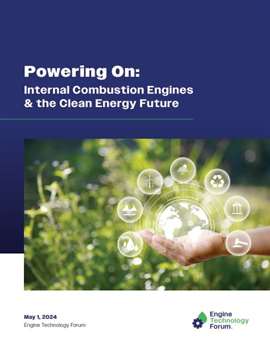Read this article in French German Italian Portuguese Spanish
ETF white paper on ICE’s role in a reduced carbon world
02 August 2024
Internal combustion engines (ICE) are the prime mover of the modern world’s economies and will serve in this role for the foreseeable future, according to a new white paper from the Engine Technology Forum (ETF).
 The white paper provides a look at ICE technology, how it is evolving and how it competes with emerging alternatives. (Source: Engine Technology Forum)
The white paper provides a look at ICE technology, how it is evolving and how it competes with emerging alternatives. (Source: Engine Technology Forum)
Powering On: Internal Combustion Engines & the Clean Energy Future was commissioned by ETF and prepared by ECOpoint, Inc., Ontario, Canada, with Addy Majewski as principal author. It provides a comprehensive look at ICE technology, how it is evolving and how it competes with emerging alternatives. The major challenges for ICE are discussed, electric and fuel cell alternatives are identified and technical, policy and market issues are explored.
The white paper specifically examines the magnitude of the global reliance on ICE and the difficulties of transitioning to different energy systems. It describes challenges to displace ICE as “formidable” and the cost, complexity, policies and capital investment required as “unprecedented.” It adds that the challenges and barriers to transitioning from fossil fuels to a renewable energy economy are “still underappreciated.”
“Our global economy relies almost solely on internal combustion engines for all of its power and mobility needs. All decarbonization technologies that are being implemented, or considered, face various limits and barriers,” said ETF’s Executive Director Allen Schaeffer. “ICEs are uniquely positioned for the future, leveraging today’s fossil-fuel based economy and adapting to tomorrow’s more sustainable one that relies on renewable fuels and dramatically reduced carbon.”
While increasingly stringent future standards are intended to accelerate the introduction of zero-emissions vehicles, a lag in funding support, infrastructure, market acceptance and other factors inherent in introducing new fuels and energy systems have produced delays and uncertainties.
In contrast, various market forecasts predict as much as 9% combined annual growth rates for ICEs from 2023-2030. In addition, it is projected that ICE technology will continue to power one-third to one-half of the new vehicle fleet in 2032, and 75% of new models of the largest commercial vehicles. The staying power of advanced ICE is even more pronounced in heavy-duty off-road applications in agriculture, construction, marine, rail and power generation, said white paper noted.
Consequently, more rapid advancement in decarbonization efforts will require “an increasingly diversified energy and technology portfolio that embraces advanced ICE with a greater reliance on low-carbon renewable liquid and gaseous fuels and hydrogen,” said Schaeffer.
“It involves building on past progress to meet new emissions and fuel efficiency requirements and a considerable increase in the use of low-carbon renewable fuels like renewable gasoline, renewable diesel, renewable natural gas, biodiesel, hydrogen as well as e-fuels now under development,” he added.
Schaeffer went on to note that for many industry sectors and applications, “an immediate switch to lower carbon renewable fuels would deliver significant greenhouse gas (GHG) and other emissions reductions faster than the time it will take for a fully renewable electric power sector to emerge and realize electrification of the transport sector at meaningful scale.”
Yet, the market and demand for renewable biobased fuels for both spark-ignited and compression ignition ICE amount to only about 5% of the total U.S. transportation sector energy consumption. Fortunately, this is growing thanks to renewable fuel’s drop-in replacement nature and variable blend capabilities, which ETF said increases its utility in delivering near-term GHG reductions across all existing and new ICE fleets.
To view and download the white paper, visit https://enginetechforum.org/internal-combustion-engine-primer.
POWER SOURCING GUIDE
The trusted reference and buyer’s guide for 83 years
The original “desktop search engine,” guiding nearly 10,000 users in more than 90 countries it is the primary reference for specifications and details on all the components that go into engine systems.
Visit Now
STAY CONNECTED




Receive the information you need when you need it through our world-leading magazines, newsletters and daily briefings.
CONNECT WITH THE TEAM














